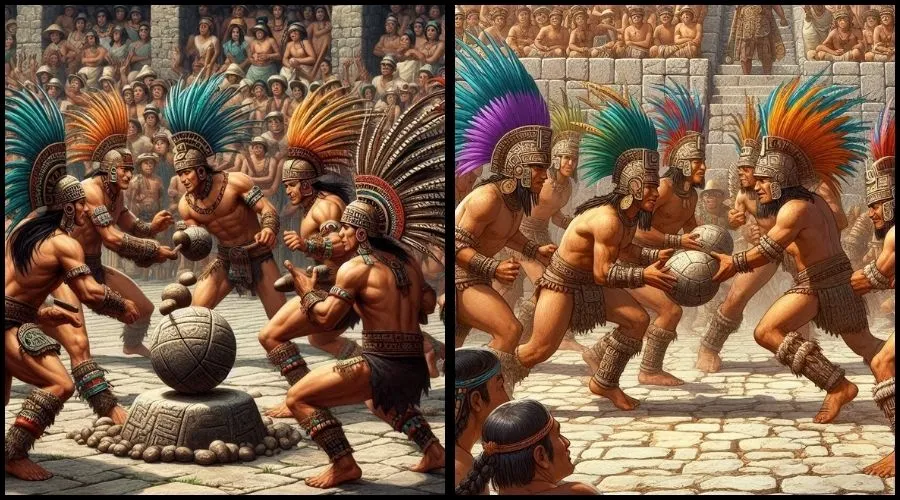Tlachtli, also called the Mesoamerican ballgame, is an ancient sport. It was played by the Aztecs and other Mesoamerican cultures. This game is considered one of the oldest team sports in the world, with a history going back over 3,000 years.
This was more than just a game; it held deep cultural, religious, and political meaning. Through this article, you are going to get all kinds of information about this Aztec Ballgame.
Tlachtli: The Aztec Ballgame
It was a ballgame played on a long, narrow court shaped like a capital “I.” The ball used in this game was made of solid rubber and was quite heavy.
Players kept the ball in play using their hips, knees, and elbows, as they couldn’t use their hands or feet. The goal was to pass the ball through stone hoops attached to the sides of the court.
How It Was Played?
It was a team sport with each team consisting of two to four players. To avoid injuries from the heavy ball, players wore protective gear like padded belts and knee pads. Playing the game required skill and agility.
Players needed to be quick and precise, using different techniques to control and direct the ball. Teamwork was essential, as players had to pass the ball to each other to keep it in play and outmaneuver their opponents.
Ball Court
The playing field for this was called a tlachtli and was shaped like a capital “I” with serifs, oriented north-south or east-west. These courts were large, with some as long as 80 meters.
The court had a flat playing area with raised sides where spectators could watch. The ball court symbolizes the heavens, with the ball representing celestial bodies like the sun, moon, or stars.
Two vertical stone rings were placed on each side of the court, representing the sunrise, sunset, or equinoxes. Players aimed to knock the ball through these rings to score points.
Rubber Ball & Gameplay
The ball used in tlachtli was made of solid rubber and was about the size of a grapefruit. Players couldn’t use their hands or feet to hit the ball; they had to use their hips, elbows, and knees.
If the ball touched the ground, it resulted in a penalty. Scoring by knocking the ball through the stone rings was very difficult.
If a team managed to do it, they were immediately declared the winner. Games often involved heavy betting, with some players even risking their freedom by staking themselves into slavery.
The Ritual & Religious Significance
Beyond being a sport, it had deep ritual and religious significance for the Aztecs.
- Teotlachco Court: The largest ball court in their capital, Tenochtitlan, was called Teotlachco (“in the holy ballcourt”). It hosted important ceremonies.
- Symbolic Battle: The game was seen as a battle between opposing forces, such as the sun god Huitzilopochtli against the moon, stars, and night.
- Sacrifices: As part of the ritual surrounding the game, captives were sometimes sacrificed to the gods.
- Honor and Status: Winning a game of tlachtli brought great honor and status. Victorious players were treated like heroes.
- Consequences for Losing: Losing captains were sometimes beheaded.
- Royal Participation: Kings and nobles were often depicted playing the game, wearing leather helmets similar to those used in early football.
The Legacy Of Tlachtli & Modern Ulama
1. Continuing Tradition
The Mesoamerican ballgame did not disappear after the Spanish conquest. A modern version, called ulama, is still played in some isolated regions today.
2. Ulama & Its History
Until recently, ulama was closely linked to warfare, and many reminders of this association remain. To make the game more accessible and connect it with its ancient origins, it has been rebranded as “Ulama” at the international level.
3. Similarities To Modern Football
Although the rules and equipment of this were different from modern football, the two sports have some striking similarities.
Both involve keeping a ball in play using the body, and the goal is to score points. The competitive nature and cultural importance of this game also reflect how football is valued in many societies today.
4. The Connection Between Tlachtli & Football
Football is the world’s most popular sport today, but its roots go back thousands of years to the ancient Aztec ballgame, tlachtli.
This ritual sport not only predates football but also influenced the political, religious, and social aspects of Mesoamerican civilizations. The legacy of this game continues in the modern game of ulama and in the universal human love of sports.
FAQs
The earliest evidence of the Mesoamerican ballgame dates back to at least 1650 BC, making it one of the oldest sports in human history.
Q.2 What did the ball court look like?
The ball court called a tlachtli, was shaped like a capital I with serifs and oriented north-south or east-west. It represented the heavens, with the ball symbolizing celestial bodies like the sun, moon, or stars.
Q.3 What was it used for?
It was used for both sport and ritual. It was often played during religious ceremonies and held great cultural significance.
Q.4 What happened to the losing team in this game?
In some cases, the losing team, or even the winning team, could be sacrificed to the gods. This added a serious and often deadly element to the game.
Q.5 Is it still played today?
Yes, traditional versions of Tlachtli, known as ulama, are still played in some parts of Mexico today. The game is also celebrated in festivals and reenactments.
Conclusion
It was more than just a ballgame. It was a vital part of the Aztec and Mesoamerican cultures. It combined sport, ritual, and ceremony. Despite its decline after the Spanish conquest, the legacy of it lives on.
It has influenced modern sports and continues to be celebrated today. Understanding Tlachtli gives us a deeper insight into the rich and complex history of the Aztecs and their civilization.







